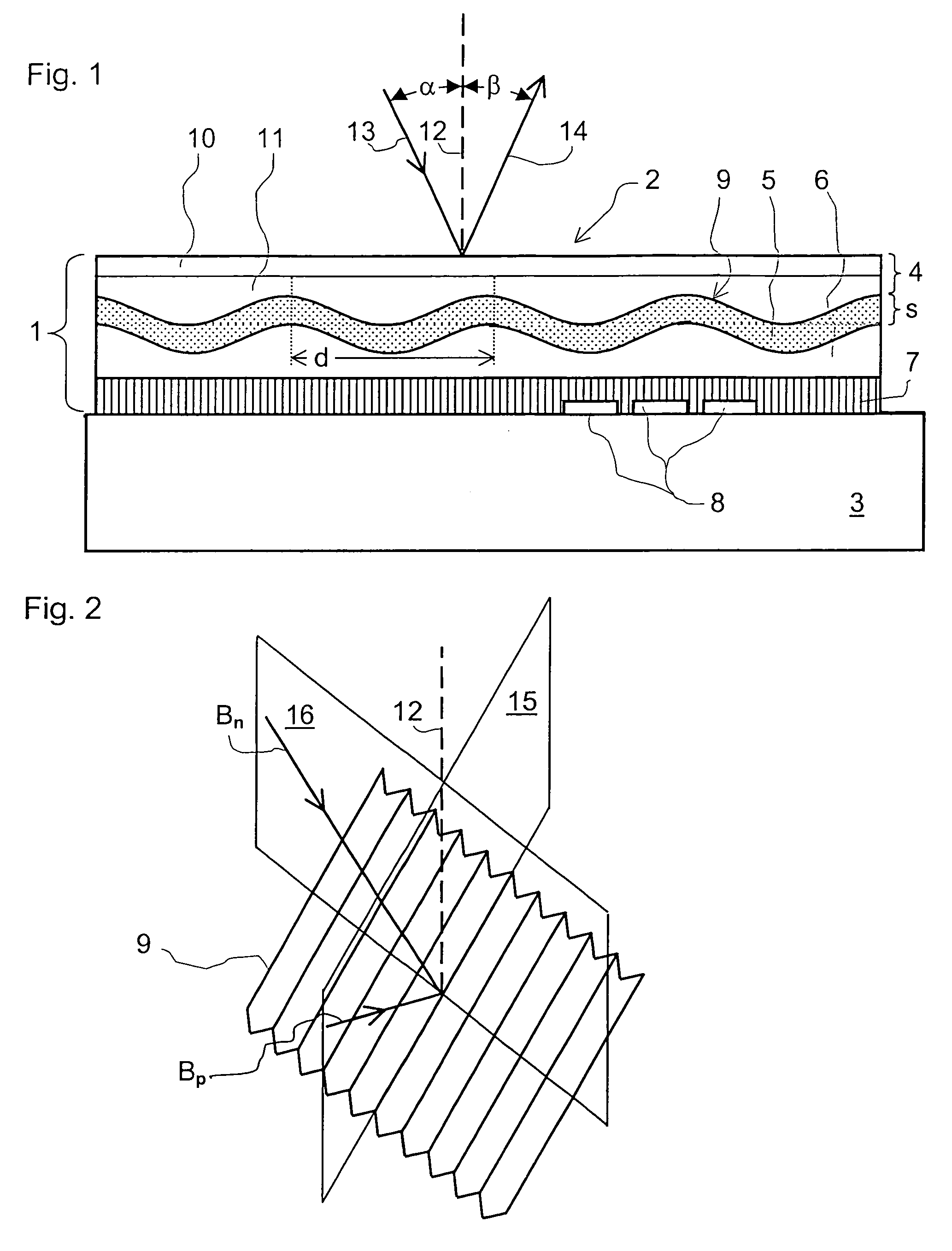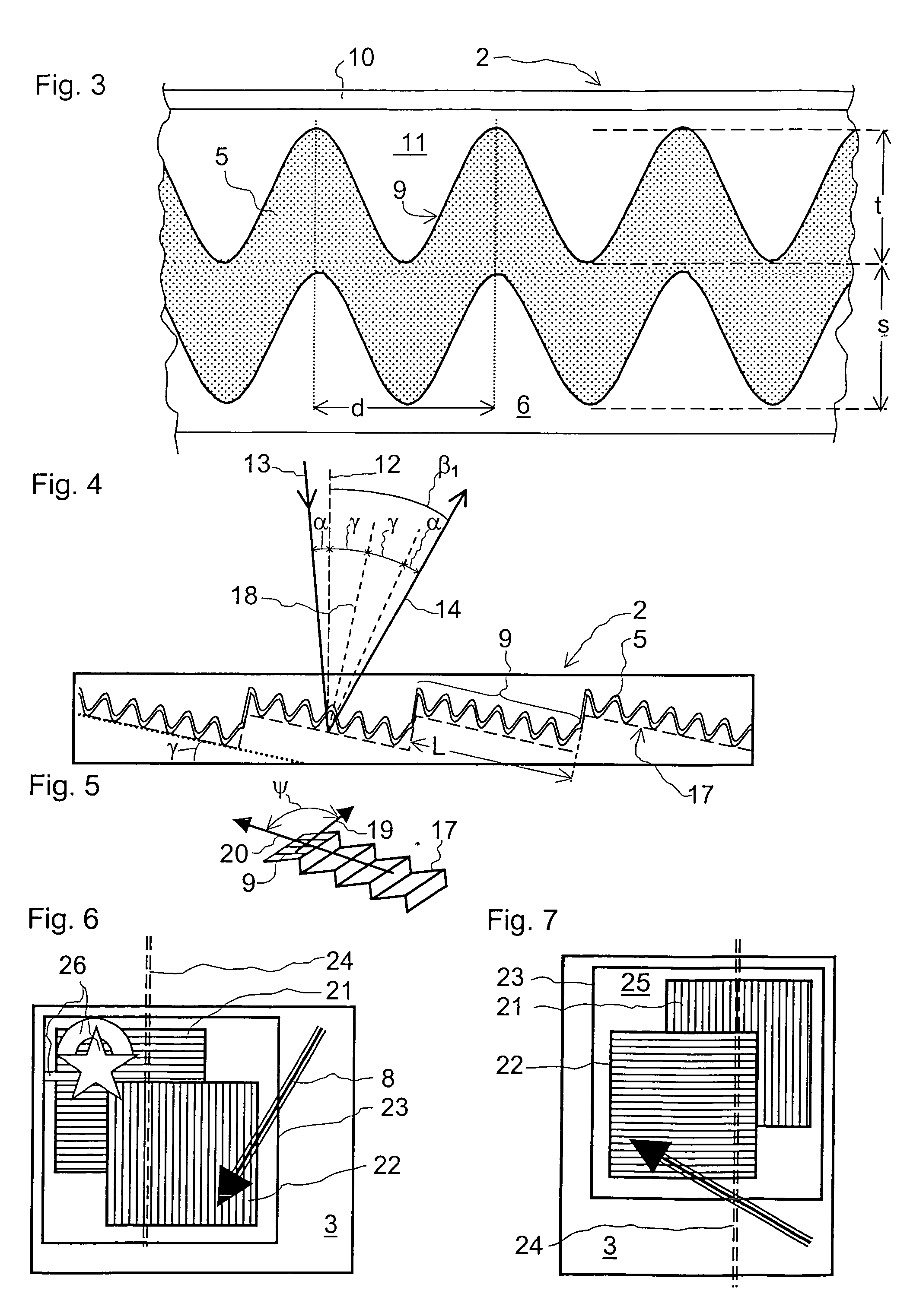Diffractive security element having an integrated optical waveguide
a technology of optical waveguides and diffractive elements, applied in the direction of printing, other printing materials, instruments, etc., can solve the problems of difficult visual recognition, difficult to recognise the shape of surface elements, and high surface brightness, and achieve the effect of easy visual recognition and simple recognition
- Summary
- Abstract
- Description
- Claims
- Application Information
AI Technical Summary
Benefits of technology
Problems solved by technology
Method used
Image
Examples
example 1
Change of Color Upon Rotation
[0033]FIG. 3 shows the waveguide 5 in cross-section on an enlarged scale. The plastic layers, the stabilisation layer 10, the shaping layer 11, the protective layer 6 and the adhesive layer 7 (FIG. 1), in accordance with Table 6 of U.S. Pat. No. 4,856,857, have refractive indices n1 in the range of between 1.5 and 1.6. The dielectric which is transparent for visible light 13 (FIG. 1), with the refractive index n2, is deposited uniformly in a layer thickness d on the optically effective structure 9 formed in the shaping layer 11, so that on the interface towards the protective layer 6 the surface of the waveguide 5 also has the optically effective structure 9. The dielectric is an inorganic compound as mentioned for example in U.S. Pat. No. 4,856,857, Table 1 and in WO 99 / 47983, and is of a value in respect of the refractive index n2 of at least n2=2.
[0034]In an embodiment of the security element 2 the values for the profile depth t of the optically effec...
example 2
Tilting-invariant Color
[0037]Another embodiment of the security element 2 exhibits an advantageous optical behaviour as, upon illumination with white unpolarised light 13, for small tilting angles, corresponding to the angle of incidence between α=10° and α=40°, the color of the diffracted light 14 remains practically invariant. The parameters of the waveguide 5, the layer thickness s and the profile depth t are here linked by the relationship s≈2t. For example the layer thickness s=115 nm and the profile depth t=65 nm. The period length d of the optically effective structure 9 is d=345 nm. In the specified range of the tilt angle with illumination with white unpolarised light 13 in parallel relationship with the grating lines of the optically effective structure 9 the diffracted light 14 is of a red color, to which the light beams BpTM primarily contribute. Upon a rotary movement of the security element 2 through a few degrees of azimuth angle the reflected color remains red while ...
example 3
Color Change Upon Tilting
[0038]If the security element 2 is rotated in such a way that the incident light 13 is directed in perpendicular relationship to the grating lines, the security element 2 of Example 2, upon tilting about an axis in parallel relationship with the grating lines of the diffraction grating, exhibits a color shift: for example the observer views the surface of the security element 2 with perpendicular incidence of light, that is to say with an angle of incidence α=0°, as an orange, with an angle of incidence α=10° the observer sees a mixed color comprising about 67% green and 33% red and with an angle of incidence α=30° he sees an almost spectrally pure blue.
PUM
 Login to View More
Login to View More Abstract
Description
Claims
Application Information
 Login to View More
Login to View More - R&D
- Intellectual Property
- Life Sciences
- Materials
- Tech Scout
- Unparalleled Data Quality
- Higher Quality Content
- 60% Fewer Hallucinations
Browse by: Latest US Patents, China's latest patents, Technical Efficacy Thesaurus, Application Domain, Technology Topic, Popular Technical Reports.
© 2025 PatSnap. All rights reserved.Legal|Privacy policy|Modern Slavery Act Transparency Statement|Sitemap|About US| Contact US: help@patsnap.com



